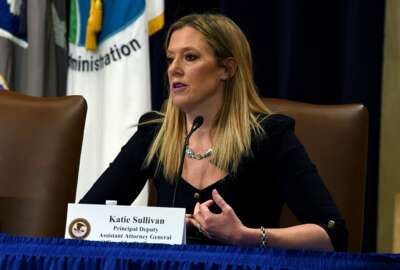New academic report measures quality of federal management
Academics at the Univ. of Illinois have sought to identify what they call six foundation blocks for a governmentwide initiative to measure management quality.
Best listening experience is on Chrome, Firefox or Safari. Subscribe to Federal Drive’s daily audio interviews on Apple Podcasts or PodcastOne.
How do you measure management quality in federal agencies? A pair of academics at the University of Illinois has sought to identify what they call six foundation blocks for a governmentwide initiative to measure management quality. UIC professor James Thompson joined Federal Drive with Tom Temin for more discussion.
Interview transcript:
Tom Temin: Professor Thompson, good to have you on.
James Thompson: Thank you.
Tom Temin: You were studying parameters by which a federal agency could measure its own management and you came up with six basic, I guess, building blocks, what was your methodology and what did you come up with?
James Thompson: So my colleague and I, her name is Alejandra Medina, she’s a PhD student in our program here at the University of Illinois, Chicago, but she and I spent about a year talking to various people. We talked to individuals in other countries that have developed programs to assess the quality of the management of their agencies, such as the United Kingdom, Australia, New Zealand and Canada. And then we also looked at a number of instruments that had been developed to assess the quality of management of private companies in the US. And so we were intrigued by what we learned. And our essential central idea was that some such methodology at to be developed to assess the quality of management of federal agencies.
Tom Temin: Because there’s this whole apparatus of oversights, and congressional committees, and the GAOs, and IGs, it seems like all they do is measure the effectiveness of management — but you’re looking for something somewhat different, sounds like?
James Thompson: Yeah, this is different than the whole, you know, Government Performance and Results Act regime, which is, you know, all designed to assess program results. What we’re looking at is kind of a precursor to performance, which is, you know, the process by which performance is achieved. It’s often kind of understated or overlooked. when it comes to looking at what agencies do, you know, the policymakers are often reluctant to get down into the weeds to say, well how well did the systems work? How well do the various HR and it and acquisition processes work? I mean, it’s all really coming to head right now in this COVID-19 crisis where we’re seeing all these systems break down at the state and federal levels — unemployment system, small business loan system, IRS is trying to get checks out, and it’s times like this, that the weaknesses of these systems become apparent. So what we’re saying is, by developing a means of assessing how well agencies are managed in times other than those of crisis, we can bring attention to these essential systems and then by the time the next crisis hits, agencies are prepared.
Tom Temin: So what might some of the measures be and some of the things to look at to measure effectiveness then?
James Thompson: So, that’s one of the issues that the taskforce, the Senior Executives Association has just created a task force to look into all this, but one of the questions is to what extent can you assess management quality strictly on the basis of a set of metrics? So for example, the Federal Employee Viewpoint Survey results, might be one such metric. The General Services Administration collects data on manager satisfaction with support services. The OMB has just started collecting data on customer satisfaction with agency services. You could conceivably compiled a set of metrics that would help get you partway there, but based on our research, we think there also is a qualitative element. In other words, you would have to have one or more people kind of go into an agency and ask pointed questions of senior leaders as to how systems are used and how well they work.
Tom Temin: Got it? So what might some of the questions be?
James Thompson: Well, for example, you know, agencies will say, Well, yeah, we have a strategic plan. But the real question becomes, what do you actually use the strategic plan in your day to day decision making and if you get at that, you might actually have to go down several levels, talk to managers at the middle level of the agency and say, well, to what extent do you pay attention to the strategic plan, to the various performance measures that have been identified as key to the agency’s success? And if they’re saying, well, we don’t really pay that much attention to it, then that gives you a lot of insight to the whether the agency is really in fact using these different tools.
Tom Temin: And getting back to some of the countries that you spoke with, Great Britain and so on, what were some of their practices, if they had them, for measuring quaity?
James Thompson: It’s really interesting, because the model that the UK developed, and it was considered to be somewhat of a substantial success during the time it was in place. But what they did is they actually recruited a set of executives, both from other national level agencies, but also from the private sector, they would create teams of three to four of these executives, the executives would be given a protocol that was developed by the Prime Minister’s Office, they would go into an agency and they would ask a whole set of questions, like 30 questions, of the senior leaders over a course of two or three weeks to really probe and get at how well that agency was managed. And then then they would serve as consultants to an extent and they would give the agency’s advice and say, Well, here’s what we’ve learned. Here are some weaknesses. Here’s some areas we think you can improve. And by and large, the, you know, the results show that the agencies came to appreciate the advice that they got and it did in fact help them improve how well they were managed.
Tom Temin: Now in the United States, as in all those other countries, you’ve got a standing professional civil service workforce, and then you’ve got political appointees. Where does all of this effort really start and center on? Would it be the political appointees? It sounds like it would be more of the standing workforce?
James Thompson: Yeah, that’s a really good question. And that’s a key question as well. But, you know, inevitably you’d have to include both, but one of our ideas what this would have to be embedded kind of at the senior executive level, which is the career workforce, which is to have any kind of a program that’s going to have any kind of impact, they would have to be sustained over time. And it’s not gonna be sustained by political appointees who come and go, you know, with some regularity, it really needs kind of buy in at the senior executive level, which is one reason why the Senior Executives Association has helped sponsor this initiative and has helped create this new task force that’s that’s going to try to develop the program
Tom Temin: Because there is lots of opportunity for conflict. I’m thinking of, say the practice of telework, which might be a great management practice, a great benefit to agencies operationally, that has nothing really to do with what policies they’re pursuing, based on the administration. And yet, now you have one administration that really pushed telework. And now you have a subsequent administration that is trying to cut back on telework. So sometimes, what seems like nothing to do with policy, does get into the management and operation of agencies day by day.
James Thompson: Yeah, I think that’s right. I mean, teleworks a good example, which is some agencies were much better prepared than others, not that they they anticipated a crisis of this magnitude, but they had in place the essential mechanisms whereby when something such as this crisis occurred, they were, at least they had the infrastructure in place so that their workers could work remotely. Regardless of the specific policy of the specific administration, you know, question is, if an agency is well managed, they’re at least contemplating these kind of things, and having placed that as I say, that infrastructure, so that when things happen, such as we’re now experiencing, they’re ready for these kind of crises.
Tom Temin: Alright, so you have done the report, you have done the interviews and come up with kind of a framework for instituting better performance measurement and management and looking at it. Now you’re partnering with the IBM Center for the Business of Government and the SEA. What happens now?
James Thompson: So SEA has created a task force. Right now, I think there’s six individuals. It’s headed by Noha Gaber, who was executive at the Architect of the Capitol, although she’s working on this and her unofficial capacity. But nevertheless, you know, they have our report as kind of a basis, and in the report we’ve identified a set of questions that need to be addressed. And these are very senior well experienced executives from throughout the executive branch who are on this task force. So basically, we’re going to be looking to them we and the SEA going to be looking to them for how to make this work. How can we put into place a program that actually will achieve what it’s intended to achieve, which is to improve management practices in the federal executive branch. And also induce a sense of learning across agencies, which is as agencies that are well managed or identified, other agencies can look to those agencies. And so what can we learn from these other agencies about how well are managed. But it’s not a trivial task to put together a program that’s really a people consider to be valid and, you know, worth the effort to engage it.
Tom Temin: Who knows maybe with Heaven’s grace, they could even fix the hiring process at some point.
James Thompson: Well, you know, that’s one of my pet peeves, because I’ve been studying civil service and civil service reform for 20 plus years. And you know, it’s the kind of thing that it just never gets to the level of visibility where policymakers are willing to take it on — but maybe through a program like this, if you can document this is a problem that’s impeding agencies from being well managed, you know, maybe eventually you can get policymakers to take on issues like that.
Tom Temin: Jim Thompson is Associate Professor of Public Administration at the University of Illinois. Thanks so much for joining me.
James Thompson: You’re most welcome. Thank you.
Copyright © 2025 Federal News Network. All rights reserved. This website is not intended for users located within the European Economic Area.
Tom Temin is host of the Federal Drive and has been providing insight on federal technology and management issues for more than 30 years.
Follow @tteminWFED
Related Stories





